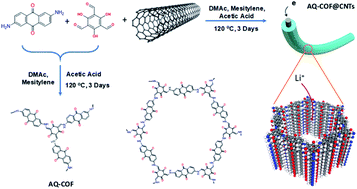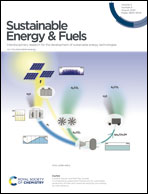Surface controlled pseudo-capacitive reactions enabling ultra-fast charging and long-life organic lithium ion batteries†
Abstract
To develop ultra-fast charging and long-life lithium ion batteries, a surface-controlled pseudo-capacitive reaction mechanism for high-performance organic lithium ion batteries is developed based on a coaxial nanocomposite of an active anthraquinone-based covalent organic framework (AQ-COF) and carbon nanotubes. AQ-COF was grown on the surface of carbon nanotubes (AQ-COF@CNTs) through in situ polymerization to improve the conductivity and to facilitate electrochemical properties. AQ-COF grown on CNTs exhibited excellent rate performance and was found to retain 76% of its initial capacity at a current density of 5000 mA g−1 (33C), and even retained 48% at an ultra-high current density of 10 000 mA g−1 (66.7C). Furthermore, under long term cycling performance investigations, the AQ-COF@CNT based cathode retained 100% of its initial capacity even after 3000 charge–discharge cycles. We further evaluated the charge storage mechanism and found that pseudocapacitance arising from surface-controlled redox reactions, coupled with excellent charge-transfer properties owing to the conductive CNT network and facilitated by the large surface area of active material, is mainly responsible for this excellent rate and cycling performance.



 Please wait while we load your content...
Please wait while we load your content...